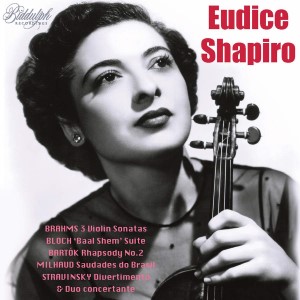
Eudice Shapiro (violin)
Ralph Berkowitz (piano), Brooks Smith (piano: Stravinsky)
Paul Weston and his orchestra (Kreisler, Provost)
rec. 1957, except Stravinsky 1962, Kreisler and Provost 1958
Biddulph 85026-2 [79 + 77]
Eudice Shapiro was born in Buffalo, New York, in 1914 and took her first steps on the violin under the guidance of her father, a professional musician. At 17 she entered the Curtis Institute in Philadelphia, where she studied with the renowned violinist Efrem Zimbalist who was also the director there. Apparently he only taught men but made an exception for Shapiro. In 1941 she relocated to Los Angeles and began playing in Hollywood studios for Paramount, United Artists and RKO. She became the first female concertmaster in any studio orchestra and held her Hollywood posts for 23 years. It was a male-dominated industry and she paved the way for future generations of female musicians. From 1956 she held a teaching post at the University of Southern California, and it was as a faculty member that she became great friends with Jascha Heifetz. She was also closely associated with Igor Stravinsky, performing with him on many occasions. Shapiro died in 2007 at age 93.
The bulk of this 2 CD set is devoted to the three Brahms Sonatas for Violin and Piano in which she’s partnered by Ralph Berkowitz in recordings set down in 1957. Berkowitz was on the teaching staff of the Curtis Institute and worked with many big names such as Gregor Piatigorsky, Jan Peerce, Felix Salmond, and George Enescu. He lived to the grand old age of 100. The Sonatas were penned in the composer’s maturity, and are noted for their unrivalled richness. The artist approaches them with emphasis on the lyrical aspects of the music, especially in the opening and slow movements of the first two Sonatas. The ensemble is fluid and wonderfully spontaneous. Shapiro’s vibrato is intense yet warm, and she’s not averse to the occasional Heifetz slide. Berkowitz reveals the rich piano writing, underlining the bass. In the D minor Sonata, the most difficult of the three to bring off, Shapiro fully meets the technical challenges, especially those in the finale. This collaboration, however, doesn’t displace the Josef Suk-Julius Katchen partnership which, for me, remains the benchmark.
Ralph Berkowitz also accompanies Shapiro in the shorter works by Bloch, Bartók, Milhaud and Ravel. Together with the Brahms Sonatas these were first released on Vanguard. Though Bloch’s Baal Shem (Three Pictures of Chassidic Life) is suffused with the flavour and rhythms of traditional Jewish music, the melodies belong to Bloch himself, with the exception of the Polish/Yiddish folksong in the third piece titled Simchas Tnorah. The second piece Nigun is the best known, and Shapiro captures the melancholic demeanour of the music in her rich, expressive and burnished tone. I love the way they deal with Bloch’s soaring climaxes throughout the suite. The Bartók works are particularly successful. Shapiro has a real flair for this music, having a perfect grasp of their idiom and style. The Romanian Folk Dances are appealing and conveyed with true gypsy swagger, complemented by Berkowitz’s malleable pianism. The delicious Saudades do Brasil by Milhaud were originally a suite of 12 pieces for piano solo. Shapiro plays 6 here. Each dance is based on a duple tango or samba rhythm and bears the name of a place or neighbourhood in Rio de Janeiro. They convey the warmth of the sunny climes in their intoxicating polyrhythms. Ravel’s Kaddisch is wistful and weeping in its long contoured lines, all the better for Berkowitz’s sensitive and discreet accompaniment.
Stravinsky emigrated to the States in 1939 when war loomed. He eventually settled for some 30 years in Los Angeles. It was here he met Eudice Shapiro. The two became friendly and the violinist championed his music, especially the Violin Concerto. The Stravinsky recordings we have here were made by Äva Records in 1962 (a label co-founded a year earlier by none other than Fred Astaire). Shapiro’s partner is pianist Brooks Smith, Heifetz’s long-time accompanist. There are two works, the Duo concertant (1932) and the Divertimento after The Fairy Kiss (1934) arranged by Samuel Dushkin. Shapiro excels in this music with tight rhythmic control and crisp articulation. Smith is the perfect partner, fully supportive and sensitive to the music’s line at all times.
Two attractive arrangements of film music complete the set. They’ve been made by Paul Weston who conducts his own orchestra. They are Kreisler’s Stars in My Eyes from Sissy and Provost’s Intermezzo from Escape to Happiness. Shapiro’s rich vibrant tone emerges in the glow of Hollywood lushness.
This is a lovingly restored aural document of an exceptional violinist and remarkable musician. It’s bolstered by excellent documentation courtesy of Wayne Kiley. Violin mavens will welcome the beautifully produced colour reproductions of Shapiro’s Peter Guarneri violin, which cover four pages. They will have every good reason to snap up this set without delay.
Stephen Greenbank
Previous review: Jonathan Woolf (May 2023)
Help us financially by purchasing from


Contents
Johannes Brahms (1833-1897)
Violin Sonata No. 1 in G major Op.78 (1878)
Violin Sonata No. 2 in A major Op.100 (1886)
Violin Sonata No. 3 in D minor Op.108 (1886-1888)
Ernest Bloch (1880-1959)
Baal Shem Suite ‘Three Pictures of Chassidic Life’ (1923)
Béla Bartók (1881-1945)
Rhapsody for violin and piano No 2, Sz.89 (1929, rev 1935)
Romanian Folk Dances, Sz.56c (1915) arr. Zoltán Székely
Darius Milhaud (1892-1974)
Saudades do Brasil, Op. 67 (1920-21)
Maurice Ravel (1875-1937)
Deux melodies hébraïques, No.1 Kaddisch (1914)
Igor Stravinsky (1882-1971)
Duo concertant (1932)
Divertimento after The Fairy Kiss (1934) arr. Samuel Dushkin
Fritz Kreisler (1875-1962)
Stars in My Eyes from Sissy (1932) arr. Paul Weston
Heinz Provost (1890-1959)
Intermezzo, from Escape to Happiness (1938) arr. Paul Weston


















